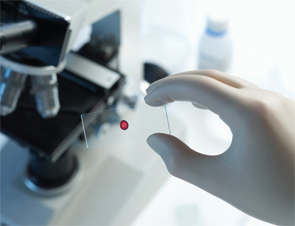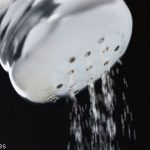
A scientist places a blood sample under a microscope in the laboratory.
Image Credit: 18percentgrey/shutterstock.com
SAN FRANCISCO—T follicular helper (Tfh) cells are emerging as an important subset of cells now recognized as important to facilitating an adaptive immune response. Developed during dendritic cell priming in vivo, these cells represent one subgroup among many of effector cells that result after naive CD4+T cells differentiate. Other well-known subgroups include Th1 cells, Th2 cells, Th17 cells and iTreg cells. Each of these subgroups elicits different immunological effector functions. For example, Th1 cells are involved with clearing viruses, Th2 in responses to helminthes (worms), Th17 in clearing fungi, and iTreg cells in suppressing immune responses at mucosal surfaces. The specialized function of Tfh cells is offering B cell help, which is critical for adaptive immune responses.1
During a session titled, T Follicular Cells and Their Mediators, at the 2015 ACR/ARHP Annual Meeting, a panel of experts spoke on current and emerging research on the basic science underlying Tfh cells (also referred to as follicular B helper T cells) and the increasing understanding of how these cells contribute to antibody responses.

Dr. Craft
Among the speakers was Joseph E. Craft, MD, Paul B. Beeson Professor of Medicine (Rheumatology) and professor of immunobiology, section chief, Rheumatology, Yale School of Medicine, New Haven, Conn., who, along with providing an overview of the development and function of these cells, spoke on their role in autoimmune disease.
“Follicular B helper T cells are critical for T-dependent antibody responses upon pathogen or vaccine challenge,” he said.
For rheumatologists, the importance of understanding their function, developmental pathways and regulation is highlighted by the role these cells play in autoimmune diseases. “When Tfh cells are aberrantly regulated, they promote pathogenic autoantibody production in rheumatic diseases,” he said, citing systemic lupus erthymatosus (SLE), anti-citrullinated protein antibodies (ACPA) positivity, rheumatoid arthritis (RA) and anti-neutrophil cytoplasmic antibodies (ANCA) positive vasculitis.
Tfh & SLE
To help rheumatologists understand the complex mechanisms behind Tfh cells, Dr. Craft described research showing an association between circulating Tfh cells and SLE.
In a study to assess the relationship between circulating Tfh-like CD4+ T cells and disease activity in patients with SLE, Choi and colleagues, among them rheumatologists of the Eloisa Bonfa group in São Paulo, Brazil, compared blood samples from patients with SLE and those with Behçet’s disease to blood samples from healthy controls.2 Circulating Tfh-like cells in all samples were enumerated using flow cytometry, and their frequency was compared with that of circulating plasmablasts (CD19+IgD-CD38+). A possible association of Tfh-like cells with the SLE Disease Activity Index (SLEDAI) was also determined.
The study found that the circulating Tfh-like cells were expanded in the blood of SLE patients compared with controls, as noted by the high levels of CXCR5, inducible T cell costimulator (ICOS) and programmed death 1 (PD-1) protein found in the SLE patients. Research has shown that expression of CXCR5, ICOS and PD-1 are markers of circulating Tfh-like cells. Compared with controls, expression of PD-1 was significantly elevated in circulating Tfh-like cells in the patients with SLE and PD-1 expression among patients with high CXCR5 circulating Tfh-like cells correlated with SLEDAI, frequency of circulating plasmablasts and anti-double-stranded-DNA antibody positivity. No relationship was found with duration of disease or past organ injury.
This study, said Dr. Craft, showed that Tfh-like cells are correlated with disease activity and aberrant B cell function in patients with SLE.
New Therapies?
According to Dr. Craft, this type of research will help us better understand the function and role of Tfh cells in autoimmune diseases and help identify what, ultimately, is the goal of this research—better treatment.
“By understanding these events, we better utilize current, or develop new, therapies that block their provision of pathogenic B cell help in the rheumatic disease,” he said, ending with a final question left for ongoing and future research to answer.
“Are therapies that block Tfh–B cell interactions in SLE, and other rheumatic disease, clinically effective, and if so, does therapeutic efficacy correlate with Tfh-cell or circulating B cell numbers and function?” he asked.
Mary Beth Nierengarten is a freelance medical journalist based in St. Paul, Minn.
Second Chance
If you missed this session, it’s not too late. Catch it on SessionSelect
http://acrannualmeeting.org/resources/sessionselect
References
- Craft JE. Follicular helper T cells in immunity and systemic autoimmunity. Nat Rev Rheumatol. 2012 May 1;8(6):337–347.
- Choi JY, Ho JH, Pasoto SG, et al. Circulating follicular helper-like T cells in systemic lupus erthematosus: Association with disease activity. Arthritis Rheumatol. 2015 Apr;67(4):988–999.

